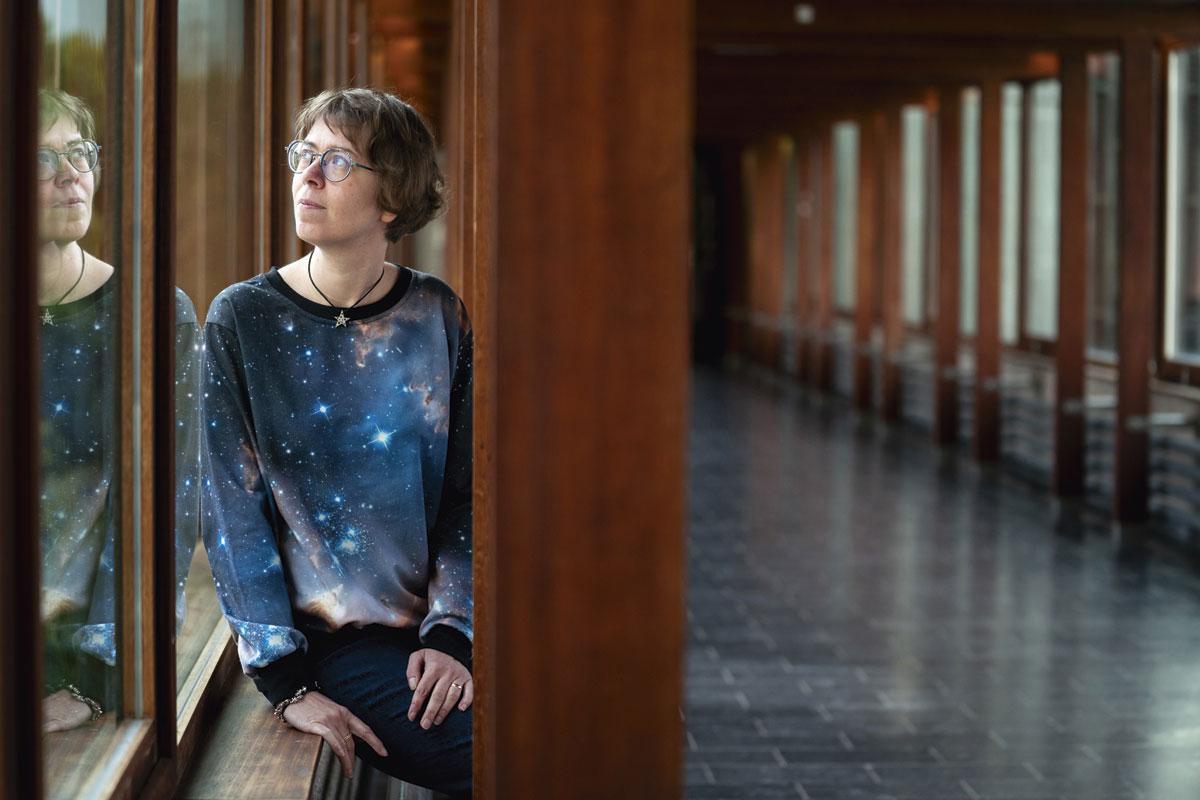Wanting to be an astrophysicist at the age of 10, Yael Nazih is now an expert on massive stars. Wanting to demystify the field, she now writes books and participates in conferences to popularize and discover female astronomers.
This is not the subject of the show. But the first PowerPoint slide by British astrophysicist Jocelyn Bell caught the attention of Yael Nazih. there is something: stars, a lithograph made by Russian painter Wassily Kandinsky in 1938, has everything from an orb. As colorful as it is fleeting. As absorbing as it is mysterious. On that day in August 2012, at the heart of the General Assembly of the International Astronomical Union in Beijing, the Belgian was blinking. “I knew it was time for me to start. It goes way back, more than a decade after the event. When I got back, I immediately started writing a book about art and astronomy.” released three years later, Art and astronomy. Heavenly impressions (Omnisciences, 2015) Again The history of art in its relation to the sky. Recently, a researcher created a new, at first glance, surprising connection by giving a lecture on music and astronomy, accompanied by her 12-year-old daughter on the violin. “For the ancient Greeks, there were seven planets. When creating the scale, they chose seven notes. Thus, heavenly music comes from the perfect sounds generated by the movement of the planets. The link between music and the stars is organic. Some composers, for example, used data about the stars to create their works. Then there are all those compositions by the Rolling Stones, David Bowie or even Björk that are inspired by concepts or objects or sky explorers.” Science and culture have one thing in common: curiosity. it’s the truth Concern for the world, for others, for what is not oneself. And continue to do so.”
Philosophy, photography, news… astrophysicist Boren has a knack for opening diverse, accessible doors to science. A way to share his passion, to encourage future vocations, and more pragmatically, to show how public money can be used. “Many are afraid of science. Astronomy is, in my opinion, a good icebreaker. Because it includes all the big questions – Where did we come from? Where are we going? Are we alone? – and because it is a science from which we can draw interesting examples everywhere, among the indigenous peoples as among the Mayans or in certain regions of Africa. Astronomy is universal and globalized and can be done by anyone, regardless of location on Earth or gender.”
Vogue at any cost
Yael Nazih practices the dissemination of knowledge. For twenty years, she has presented at conferences around the world and written dozens of books, which have been regularly critically acclaimed: The colors of the universe (Bellin, 2005), ancient astronomy (Bellin, 2009), Book (g) Astronomy. Universe Kitchen (Rejoice, 2012). “It’s a lot of prep work to learn the subject every time. The goal is to simplify without oversimplifying. Avoid excessive technical jargon, but use the right comparisons or references to popular culture. We must be able to stick to what is said.”
The Bodor citizen used to write during her teens. Essentially, physics and astronomy texts that lingered in his drawers, but turned out to be as useful as the bewildered reactions of his interlocutors when the information was not adequately explained. “There are very tangible simplification devices like crafts with kids or escape games with older kids. We must not believe that we have to reinvent hot water every time. The idea is to discuss, to open up, to have fun…” Perhaps this is exactly what annoys some players in the academic world. Because if Yael Nazih gets prizes like the Astronomical Book Prize or the prestigious Jean Perrin Prize, she will also face a real boycott from several colleagues in her floor when her book comes out The first in 2005. Something he also reminds her of the day she was slapped on the fingers for giving an interview that all her previous collaborators had refused to do.”There is a growing awareness of the importance of communicating science, But some see merchandising as a way of showing off, which is not the case at all.” It also happens that the current Seraing citizen disappears from the scene during her conferences. Too short and you should settle to the back of the room.” I tell a story that I make clear, my voice serving as a guide. What matters are the beautiful pictures and the content, not me!»
In 2006 a book entitled female astronomy (CNRS Editions), the forty-year-old insisted on highlighting Journey of several women. “In the early 2000s, I thought I knew the history of my major pretty well, but I came across a list of astrological girls I didn’t know half of. I began to inquire. When I had collected all my notes, I had enough material for a book. So far Yael was untouched.” On sexual notes, she would often hear stories of women who had to fight with their feet to convince their families to let them study physics at university or to find a place for themselves in the middle.” This book was also an opportunity to show all that these women did. By highlighting these examples – and we are fortunate that the first female astronomers date back to ancient times – we will surely I admit everyone in their natural place. Anyway, the theme pleases: a new edition of the book has just been published in pocket format and we’re always inviting the scientist into conversations in circles not necessarily dedicated to science.
Mysterious stars
From her office on the second floor of Building 5C in Sart-Telman, Yael Nazih also works as a researcher at Oleg’s Liege Space Center. Fate was forged at the turn of the millennium, at the bend of a corridor, when nine hundred souls met Professor Jean-Marie Frou, of her home village of Warkeny. “Later, there will be up to seven Borinage researchers working simultaneously at the Institute of Astrophysics and the Liège Space Center. Compared to the small size of the area, it is still striking. Perhaps a reaction related to our global history: after looking at the mines for years, We wanted to catch our eyes.»
As for La Hainuyère, she began charting her course from the age of 10, the age at which she made up her mind to become an astronomer because “she was under the impression that this was the time when you had to make a decision about your future.” there was no click, The accumulation of items such as my interest in weather, and books on astronomical and space missions satisfied me. Logically unaccustomed to strong math and science courses, the very young girl then trained her own way by immersing herself in science fiction novels by Arthur Clarke and Isaac Asimov or fantasy by the Belgian Jean Ray. He also gives to his parents by tying detours during the holidays to pass through the Observatory of Haute-Provence or the Nanchai Radio Telescope. After studying electrical engineering at the Polytechnic of Mons, Yael landed at the Spatial Center de Liège and then, through Jean-Marie Vreux, proceeded to Study of massive stars.
Twenty years later, she is still using the same space telescope to observe these stars ten thousand to ten million times brighter than the Sun, mechanical energy sources, ionizing light, and chemical elements. “We will work once on the binary reaction, and again on the origin of the emission of a star… Some people still think of an astronomer as that old man who keeps his eyes glued to a telescopeBut it wasn’t like that in years. It is so diverse that there is no ordinary day and no routine either.
I enjoy doing an observational, non-theoretical activity – “I’d rather see concrete things in front of me than think in front of equations” – The astrophysicist realizes that massive stars remain Less sensationalized in the media than topics such as the limits of the universe or exoplanets. However, they are part of our culture and raise a lot of questions. The star Gamma Cass in the constellation Cassiopeia, for example, has been visible in Europe since prehistoric times … But we still do not know where its extremely high-energy emission, one hundred million magnitudes, comes from. That was much better, here it is again Something new to discover. Then to generalize.
his greatest danger
“I chose astronomy at the age of 10, an age when I didn’t know my true abilities. I probably didn’t.”
his motto
“Stay curious.”
His biggest slap
“The feeling that opposition to promotion came from colleagues rather than a public uninterested in science.”
Key dates
1986 “I am following with interest information about the passage of Halley’s Comet near the Sun.”
1997 “I am 21 years old, giving my first lecture and publishing my first articles.”
1999 Launch of the XMM-Newton telescope, the culmination of my dissertation and the beginning of my Ph.D. It still works!”
2005 “The release of my first book, The Colors of the Universe.”
2009 “Formally Become a Qualified Scholar of the Scientific Research Fund (FNRS)”.

“Music guru. Incurable web practitioner. Thinker. Lifelong zombie junkie. Tv buff. Typical organizer. Evil beer scholar.”







More Stories
Why do leafhoppers reflect little light?
Bacteria brought into space mutated and became stronger on board the International Space Station, study finds
Sperm for science used in fertilization: already 16 contacts